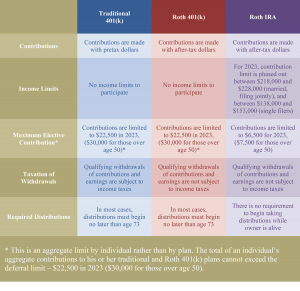While many people are familiar with the benefits of traditional 401(k) plans, others are not as acquainted with Roth 401(k)s. Since January 1, 2006, employers have been allowed to offer workers access to Roth 401(k) plans.
And some have introduced offerings as part of their retirement programs.1 As the name implies, Roth-401(k) plans combine features of 401(k) plans with those of a Roth IRA.2,3 With a Roth 401(k), contributions are made with after-tax dollars – there is no tax deduction on the front end – but qualifying withdrawals are not subject to income taxes.
Any capital appreciation in the Roth 401(k) also is not subject to income taxes.
What to Choose?
For some, the choice between a Roth 401(k) and a traditional 401(k) comes down to determining whether the upfront tax break on the traditional 401(k) is likely to outweigh the back-end benefit of tax-free withdrawals from the Roth 401(k).
Please remember, this article is for informational purposes only and is not a replacement for real-life advice, so make sure to consult your tax professional before adjusting your retirement strategy to include a Roth 401(k).
Often, this isn’t an “all-or-nothing” decision. Many employers allow contributions to be divided between a traditional-401(k) plan and a Roth-401(k) plan – up to overall contribution limits.
Considerations
One subtle but key consideration is that Roth 401(k) plans aren’t subject to income restrictions like Roth IRAs are. This can offer advantages to high-income individuals whose Roth IRA has been limited by these restrictions.
(See accompanying table.)
Roth 401(k) plans are subject to the same annual contribution limits as regular 401(k) plans – $22,500 for 2023; $30,000 for those over age 50. These are cumulative limits that apply to all accounts with a single employer; for example, an individual couldn’t save $22,500 in a traditional 401(k) and another $22,500 in a Roth 401(k).5
Another factor to consider is that employer matches are made with pretax dollars, just as they are with a traditional 401(k) plan. In a Roth 401(k), however, these matching funds accumulate in a separate account, which will be taxed as ordinary income at withdrawal.
Setting money aside for retirement can be part of a sound personal financial strategy. Deciding whether to use a traditional 401(k) or a Roth 401(k) often involves reviewing a wide range of factors. If you are uncertain about what is the best choice for your situation, you should consider working with a qualified tax or financial professional.
1. To qualify for the tax-free and penalty-free withdrawal of earnings, Roth 401(k) distributions must meet a five-year holding requirement and occur after age 59½. Tax-free and penalty-free withdrawals also can be taken under certain other circumstances, such as a result of the owner’s death or disability. Employer matches are pretax and not distributed tax-free during retirement. Once you reach age 73, you must begin taking required minimum distributions.
2. Forbes.com, January 5, 2023
3. In most circumstances, you must begin taking required minimum distributions from your 401(k) or other defined contribution plan in the year you turn 73. Withdrawals from your 401(k) or other defined contribution plans are taxed as ordinary income, and, if taken before age 59½, may be subject to a 10% federal income tax penalty.
4. Roth IRA contributions cannot be made by taxpayers with high incomes. In 2023, the income phaseout limit is $153,000 for single filers, $228,000 for married filing jointly. To qualify for the tax-free and penalty-free withdrawal of earnings, Roth IRA distributions must meet a five-year holding requirement and occur after age 59½. Tax-free and penalty-free withdrawals also can be taken under certain other circumstances, such as a result of the owner’s death or disability. The original Roth IRA owner is not required to take minimum annual withdrawals.
5. IRS.gov 2023
The content is developed from sources believed to be providing accurate information. The information in this material is not intended as tax or legal advice. It may not be used for the purpose of avoiding any federal tax penalties. Please consult legal or tax professionals for specific information regarding your individual situation. This material was developed and produced by FMG Suite to provide information on a topic that may be of interest. FMG Suite is not affiliated with the named broker-dealer, state- or SEC-registered investment advisory firm. The opinions expressed and material provided are for general information, and should not be considered a solicitation for the purchase or sale of any security. Copyright FMG Suite.
Check the background of your financial professional on FINRA’s BrokerCheck.
The content is developed from sources believed to be providing accurate information. The information in this material is not intended as tax or legal advice. Please consult legal or tax professionals for specific information regarding your individual situation. The opinions expressed and material provided are for general information, and should not be considered a solicitation for the purchase or sale of any security.
We take protecting your data and privacy very seriously. As of January 1, 2020 the California Consumer Privacy Act (CCPA) suggests the following link as an extra measure to safeguard your data: Do not sell my personal information.
Charles Sosa and Zachary Rayman are registered representative with, and securities and advisory services are offered through LPL Financial, a registered investment advisor. Member FINRA/SIPC.?
The LPL Financial registered representative(s) associated with this website may discuss and/or transact business only with residents of the states in which they are properly registered or licensed. No offers may be made or accepted from any resident of any other state.
Alternative investments may not be suitable for all investors and should be considered as an investment for the risk capital portion of the investor’s portfolio. The strategies employed in the management of alternative investments may accelerate the velocity of potential losses.
Contact Us
Lifestyle Financial
Office: (800) 834-2250
Fax: 949-241-8569
200 Sandpointe Avenue
Suite 160
Santa Ana, CA 92707
Series 7 and 66 held through LPL Financial.
Website developed & maintained by UpTree Group, LLC.





